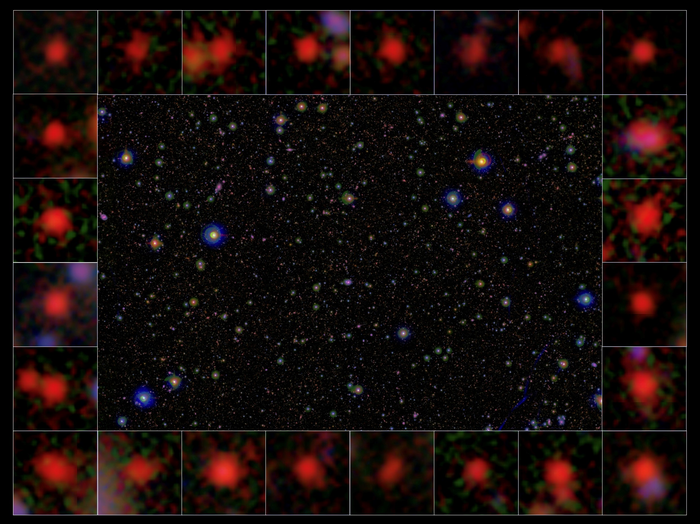While some galaxies continue to create stars, others die out and live a more passive existence. What caused these galaxies to stop creating stars at such a young age is unknown, not the least since they are so far away and dim that they go unnoticed.
 Hundreds of galaxies are seen in this region of the sky, called COSMOS. The most distant ones are seen as small, red specks, enlarged along the edge of the image. By “adding” all these galaxies a unified signal emerges, which has led scientists on the trail of the cause of the galaxies’ death. Image Credit: NAOJ.
Hundreds of galaxies are seen in this region of the sky, called COSMOS. The most distant ones are seen as small, red specks, enlarged along the edge of the image. By “adding” all these galaxies a unified signal emerges, which has led scientists on the trail of the cause of the galaxies’ death. Image Credit: NAOJ.
However, a team of astronomers led by the University of Copenhagen discovered that black holes helped switch off star creation by combining the light from thousands of galaxies.
In our galaxy, the Milky Way, a new star is born about once a year.
Some galaxies make stars more quickly than others do, and the most active galaxies in the early Universe produced hundreds or perhaps thousands of stars per year. Others, on the other hand, are pushed to the opposite extreme and cease to generate new stars entirely. Their population of stars gradually fades, leaving only the tiny, reddish stars.
The explanation for this so-called quenching, in particular in the early Universe, is unknown, though humankind knows it must have something to do with the depletion of star fuel—cold gas. However, it is unclear if the gas is being blown out of the galaxy, being heated to dangerously high temperatures, or something else.
Another concern is why galaxies remain dormant: The intergalactic space in the early Universe was dense with gas, which should eventually move toward galaxies, renewing star formation.
Black Holes Light up by Swallowing Gas
One possibility is that a dormant galaxy has a supermassive black hole at its center, which consumes nearby matter while radiating surplus energy. This form of “active galactic nucleus” would be a less intense quasar with a lower luminosity. Even so, the released energy would be adequate to heat the rest of the galaxy’s gas, preventing future star formation.
In X-ray and radio wavelengths, the galaxy should indicate a weak excess signal if this scenario is correct.
An international team of astronomers, headed by postdoc Kei Ito of Japan’s SOKENDAI University, chose to verify the notion by combing through a database of galaxies discovered in the “COSMOS field,” a region of the sky.
However, Ito and his team ran into an inherent problem with this strategy: examining early galaxies necessitates monitoring distant galaxies billions of years away due to the time it takes light to reach us. However, since distant galaxies are small, any signal that may exist is undetected in any individual galaxy in the COSMOS database.
A Stack of Galaxies
To get around this problem, the researchers opted to “stack” the galaxies’ images, which means they combined the light from all galaxies and looked at the combined signal from all galaxies at the same moment.
Although we lose the information about the state of any individual galaxy, we can now see their »average« properties. And the result is clear: A typical quenched galaxy 10–12 billion years ago hosted a low-luminosity, active galactic nucleus which may have played a crucial role in preventing rejuvenated star formation.
John Weaver, PhD Student, Cosmic Dawn Center
The Niels Bohr Institute, University of Copenhagen, and DTU Space joined forces to establish the Cosmic Dawn Center.
The research included several members of the Cosmic Dawn Center, including John Weaver. He recently oversaw the collection, cataloging, and analysis of the COSMOS field’s 1.7 million galaxies.
Now that we know the active galactic nuclei are there, we can target the galaxies individually. Future deep follow-up observations—for instance with the new James Webb Space Telescope—will provide more evidence for our proposed scenario.
John Weaver, PhD Student, Cosmic Dawn Center
Journal Reference:
Ito, K., et al. (2022) COSMOS2020: Ubiquitous AGN Activity of Massive Quiescent Galaxies at 0 < z < 5 Revealed by X-Ray and Radio Stacking. The Astrophysical Journal. doi.org/10.3847/1538-4357/ac5aaf.